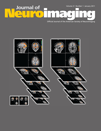Serial Neuroimaging in Tolosa-Hunt Syndrome with Acute Bilateral Complete Ophthalmoplegia
Funding Sources: None.
J Neuroimaging 2011;21:79-82.
ABSTRACT
Tolosa-Hunt syndrome (THS) is a very rare, relapsing, and remitting painful ophthalmoplegia caused by nonspecific granulomatous inflammation in the cavernous sinus. To our knowledge, bilateral complete, simultaneous palsies of all 3 cranial nerves associated with extraocular movement have not been reported. We describe the first such patient with bilateral THS that responded quickly to corticosteroid therapy. A 54-year-old man presented with a periorbital and frontal headache with acute bilateral severe blepharoptosis and fixed eyes, which dramatically responded to corticosteroid therapy. He had diabetes mellitus type II. Brain MRI showed granulomatous inflammation in both cavernous sinuses and thickening of the surrounding dura mater of the cranial base, suggesting the coexistence of focal hypertrophic cranial pachymeningitis. Our experience indicates that steroid therapy with strict control of blood sugar should be considered in patients with THS complicated by diabetes. MRI is a valuable tool for serially monitoring the response of lesions to treatment in THS.




